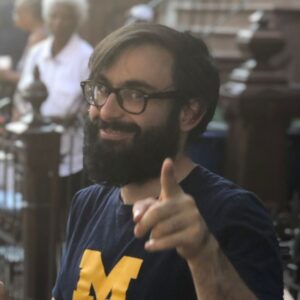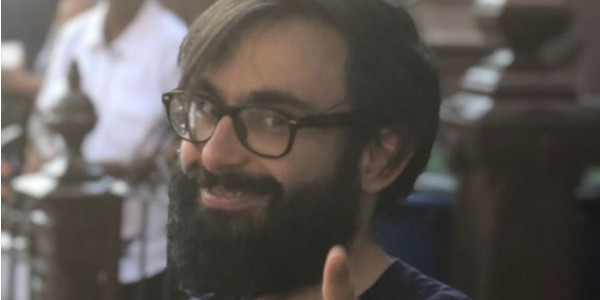Deniz Camp interview by Anthony Andujar Jr 10/27/22
 I had the privilege of interviewing the writer of 20th Century Men, Agent of WORLDE, Maxwell’s Demons. I contacted him to discuss his current work on Bloodshot Unleashed at Valiant Entertainment, and how that project came to be in regards to redefining the character.
I had the privilege of interviewing the writer of 20th Century Men, Agent of WORLDE, Maxwell’s Demons. I contacted him to discuss his current work on Bloodshot Unleashed at Valiant Entertainment, and how that project came to be in regards to redefining the character.
Q1. You’ve worked on various titles such as Agent of WORLDE, Maxwell’s Demons, and concurrently 20th Century Men and Bloodshot Unleashed. What attracted you to work on Bloodshot? Was he always a character of interest?
DC: Once I really started digging into the character what attracted me was the idea that a man who can’t die is a man of great suffering, potentially infinite. That’s when the character really came alive for me, and I knew the book had to be about the wounds the nanites *don’t* heal.
Q2. You’ve joined the latest line of writers that have provided a wealthy contribution to Bloodshot in regards to his mythos such as Jeff Lemire and Matt Kindt amongst a few other notable writers. And while many of them have touched on various topics that Bloodshot explores, you seem to have taken a more deeper approach to the character that pushes various ideas forward as a wandering weapon questioning their own programming. What were some of the themes that you explored when writing this series?
DC: I feel like questions of trauma, free will, responsibility, redemption, rebirth, and conflicting impulses are all bound up in the character, just very obviously right there. Bloodshot is a Veteran and I wanted this to feel like a book about a veteran. I think the things Bloodshot struggles with are the things that a lot of veterans struggle with, that a lot of people who have experienced trauma struggle with.
 Here’s a guy who has done horrible things and has had horrible things done to him. Here’s a guy who isn’t sure what’s real and what isn’t anymore. Here’s a guy desperately trying to be a better person, but who always seems to be falling into old, self-destructive patterns. Here’s a guy who has lost everything and keeps going anyway, keeps getting up.
Here’s a guy who has done horrible things and has had horrible things done to him. Here’s a guy who isn’t sure what’s real and what isn’t anymore. Here’s a guy desperately trying to be a better person, but who always seems to be falling into old, self-destructive patterns. Here’s a guy who has lost everything and keeps going anyway, keeps getting up.
I find that guy to be kind of tragic, but really interesting, and sympathetic. I want to know more about him. That’s the driving force of the book, for me.
Q3. What are some of the challenges that come with writing this series? Were there any changes that were made prior to the final version of your story? What are the difficulties of balancing the story and the societal and psychological themes that correlate to the character when writing this series?
DC: The biggest challenge is really just the space! We have a lot we want to do every issue, so it becomes a process of trying to fit it all in. To that end I play with structure a lot, but really it wouldn’t work without Jon Davis Hunt, who draws 16 panels on a page without making the page seem crowded. He’s such a unique talent and a wonderful creative partner.
I have a lot I want to say about Bloodshot, and about this country, in this book, and so it’s really about fitting it all into every issue without making them seem crammed or crowded while giving everyone a full story with a beginning, middle, and end. So far I think we’ve done that!
Q4. Your version of Bloodshot is a lot more visceral than previous efforts, where the character endures brutality that pushes his healing factor to the absolute limits. What was it like exploring those facets of the character and the sort of toll it has on his psyche?
DC: Yeah, that’s been a real blessing. I think a big part of the appeal for Bloodshot has always been a bit of body horror, and with the Mature Readers label, we’re able to really go far there. Again, Jon & Jordie are the main reason that works – when Jon draws someone shooting themselves in the head, it’s a thing of beauty, made more beautiful when Jordie works her magic.
What appeals to people about body horror? I’m not sure – I guess it reflects our anxieties about our own fragility and the gory horror of our existence. Either way, I think it’s very appropriate for Bloodshot and is a big part of the visual language of the book. And I think it makes the book stand out.
Q5. You’re working with a solid creative team consisting of the cinematically illustrative, Jon Davis- Hunt, legendary colorist Jordie Bellaire, and the scholarly lettering craftsmen himself, Hassan Otsmane-Elhaou. What is the creative process like collaborating with this art team? How do you correspond with each other to fully realize the vision that you all intended for this book?
DC: It’s been fantastic, extremely collaborative. I wrote full scripts, but Jon changes what he feels necessary, often adding panels to get at all the details I describe or to give moments more room to breathe. Sometimes he completely changes the layout, and once even came up with and added an important action beat. He’s a real storyteller and a brilliant creative partner and a big part of the creative success of the book. We love working together.
and added an important action beat. He’s a real storyteller and a brilliant creative partner and a big part of the creative success of the book. We love working together.
And that goes for the whole creative team – Jordie makes brilliant decisions that enhance the book, Hass is always pushing the envelope for lettering. Those 24-panel Pluto pages in issue 2 were the perfect example of every person on the creative team trying to one-up the one before, adding up to something that none of us could have done on our own.
Q6. As of this interview, we’re two issues into Bloodshot Unleashed. Did you think that you were able to preserve much of what was published thus far in the previous two issues? Were there any moments where you had to convince the editor that certain elements needed to remain in the book?
DC: I’ve had an amazing amount of creative freedom with this book. As I understand it, it’s almost unheard of for someone to get a book like Bloodshot – Valiant’s flagship character – and be given the kind of creative freedom I’ve been given. Yes, I had to argue for a lot of things – Charlie, Charlie from issue 2, and for the opening to issue 1 – but the arguments were all good arguments, keeping me honest, making sure I had a purpose to my decisions. And the editor, Rob Levin, always made a point to say that I got final say on most such decisions (within reason).
This book, for better or worse, is a reflection of the creative vision of the creative team. I feel incredibly lucky to have been given this opportunity, the freedom to make this kind of art.
Q7. Given the wonton chaos and meditative commentary that is on display in this ballistic action series, how did you manage to reconcile those themes with editorial without losing the essence that you intended to keep from start to finish?
DC: It’s actually fairly simple. The key is Bloodshot. Everything in the book is in conversation with Bloodshot, every choice made is in service of exploring, demonstrating, and/or provoking his character. From the antagonists to the towns to the memory ghosts, it’s all a part of that.
Q8. Aside from Bloodshot, were there any other characters that you were interested in writing at Valiant prior to working on Bloodshot?
DC: I always liked XO, and got the chance to write him in Bloodshot Unleashed 3, and it was great great fun.
Q9. What can readers look forward to in the following issues of this series? And what are you excited to explore with the character and beyond?
DC: We go deeper and deeper into the character with every issue. Issue 3 has XO and Bloodshot teaming up to take on an Alien parasite weaponized by the government, and it’s our darkest and most body-horror-inflected issue yet. Not for the squeamish.
Issue 4 is called “Flashback”, and it has Bloodshot facing a super soldier who is experiencing a flashback to the wars he fought in, and each time Bloodshot is killed by that super soldier HE is launched into his *own* Flashback, where we’ll see just what happened to Magic and Jessie, and how he got to where we found him in issue 1. And the whole issue is told in the future tense. It might be my favorite issue of the whole run.
time Bloodshot is killed by that super soldier HE is launched into his *own* Flashback, where we’ll see just what happened to Magic and Jessie, and how he got to where we found him in issue 1. And the whole issue is told in the future tense. It might be my favorite issue of the whole run.
Q10. What other projects do you have in the pipeline that readers should keep an eye out for?
DC: Well, as you mentioned, I have a creator-owned book from Image Comics called 20th Century Men, and I think it’s the best thing I’ve ever written. It’s basically Apocalypse Now with superheroes. Dense, complex, and filled to the brim with human moments and hauntingly beautiful art.
And I have sci-spy creator-owned book called Agent of WORLDE, which follows a secret agent as he faces aliens, time travelers, and evil spies while he tries to hide a secret from all of them. It’s filled with big, Sci-Fi ideas and absurdity that borders on grotesque, and is often compared to The Filth.

